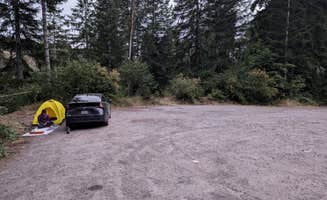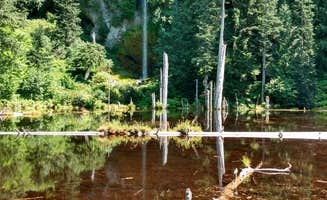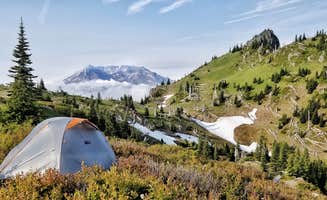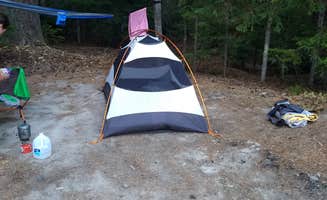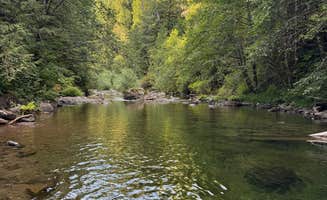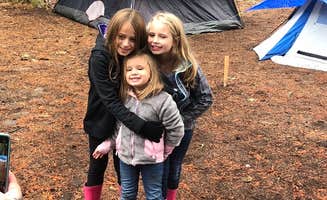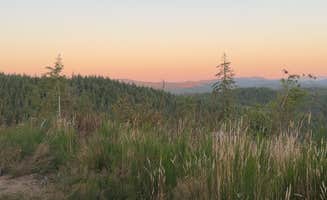Primitive camping near Castle Rock, Washington provides access to the geological wonder of Mount St. Helens and surrounding Gifford Pinchot National Forest. The area sits at elevations ranging from 1,200 to 4,000 feet with a climate that brings wet winters and moderate summers averaging 65-75°F. Several dispersed camping areas require navigation on forest roads that transition from paved to gravel surfaces, with road conditions varying based on recent maintenance cycles.
What to do
Hiking to waterfalls: At Beaver Falls Trailhead, visitors can access a short trail to an impressive waterfall. "The hike to the falls is to the far left of the pullout. Do NOT go down the super steep trails to the right. Beautiful waterfall after a short hike," advises Mike S. The trail provides opportunities for swimming during summer months.
Mushroom hunting: The forests around Mount St. Helens host abundant edible mushrooms in late summer and fall. "During August and September, you can find tons of edible mushrooms," notes a camper at Butte Camp/Climbers Bivouac. Chanterelles and morels can be found after seasonal rains.
Stargazing: Clear nights offer excellent stargazing opportunities away from city lights. A camper at Gifford Pinchot National Forest Dispersed Site reported: "Great view of the stars at night!" The tall trees can make the forest "a lot darker before it actually gets dark," so prepare accordingly with lighting.
What campers like
Solitude and privacy: Many primitive camping sites near Castle Rock offer quiet experiences away from crowds. At McBride Lake NF-81, campers appreciate that "The area has no trails, so you would not have to worry about people wandering into the campsite." Sites are often "plenty big to accommodate a few trucks/cars and one, maybe two towable trailers."
Mountain views: Some sites provide direct views of volcanic peaks. At Pumice Butte, "The camp is around a gully on the north side of Pumice Butte with outstanding views of Mt St Helens and Mt Adams." These viewpoints can become popular during peak seasons.
Riverside locations: Many primitive campsites are situated near water. At Canyon Creek, one camper noted their site "had a trail down to the creek that was nice" and recommended "the area for just a nice quiet disconnect." The sounds of flowing water enhance the camping experience.
What you should know
Cell service limitations: Connectivity is minimal throughout the primitive camping areas. At Road to Snag Lake, campers report varied experiences with "great cell reception" near the cell towers, while at McBride Lake NF-81, "There is no cell phone reception; however, if you drive East for a few miles, you may be able to get 2 bars with Verizon."
Road conditions: Forest roads require careful driving. One camper at Canyon Creek warned that "road getting in sucks," while another mentioned "about 5 miles of rough rough gravel road." Some routes may be impassable for larger vehicles or during wet conditions.
Water availability: Most primitive sites lack reliable water sources. At Pumice Butte, campers report that "Water was flowing at this camp when we passed in late July, but it was silty in the late afternoon and early evening, clear in the morning." Bring sufficient water supplies for your stay.
Tips for camping with families
Choose established sites: For families with young children, select areas with defined boundaries. Beaver Falls Trailhead offers "a wide dirt pullout with room for 7-10 cars" and feels like "you're right in the middle of the forest!" The defined space helps keep children within sight.
Plan for bathroom needs: No permanent facilities exist at most sites. Campers at Gee Creek Rest Area I-5 note this is one of few locations with toilet facilities, making it a potential first stop before heading to more remote locations.
Consider proximity to attractions: Sites closer to features like waterfalls provide easier access for families. At Beaver Falls Trailhead, "The waterfall is amazing and only a 15 minute hike down!" This accessibility makes it suitable for families with children of various ages.
Tips from RVers
Size limitations: Most primitive sites accommodate smaller RVs or trailers. At McBride Lake NF-81, one camper notes: "Due to the narrow road, it may be a bit more snug with bigger rigs (25+ feet long and anything more than 8+ feet wide). I would scout the road and area before committing."
Camp selection strategy: RVers should prioritize established turnaround areas. "There is a turnaround that you could use to maneuver the trailer to drive out. It's plenty big to accommodate a few trucks/cars and one, maybe two towable trailers," advises an experienced camper at McBride Lake.
Level sites: Look for flat areas suitable for parking. Road to Snag Lake offers "cement pad for parking" at some sites, while others have "solid pack gravel covered by grass" that can work for smaller RVs and trailers.


